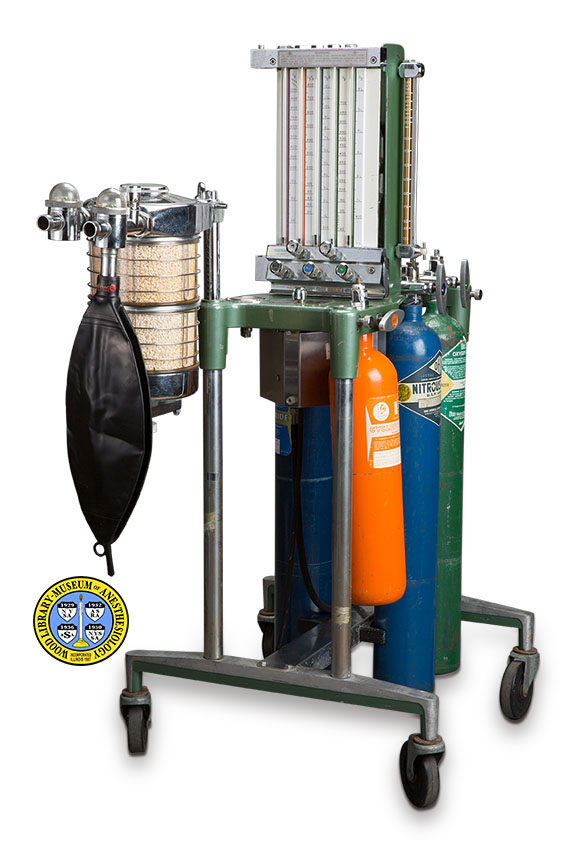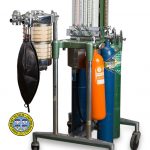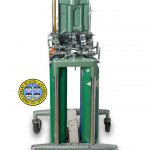Ohio Verni-Trol Machine
Numerous models of the Kinet-O-Meter anesthesia machine were made by the Ohio Company from the late 1930s through early 1970s. Depicted here is a Model 3333, introduced in 1958. The example shown here has pin-indexed yokes and flowmeters for three gases, oxygen, nitrous oxide, and cyclopropane, as well as a separate flowmeter for liquid anesthetic. Accessories such as the carbon dioxide absorber (seen on the left front corner) could be mounted on any of the stand’s four posts. This machine also incorporated an oxygen flush valve, used to quickly replace the anesthetic vapor with oxygen when needed.
Models in the Kinet-O-Meter 2000, 3000 and 4000 series came equipped with a Verni-Trol Vaporizer. In several respects, this imitated the Copper Kettle Vaporizer that had been introduced six years earlier by Foregger, a competing company. Similar features included a metal housing and a bubble pump that retained heat. This increased the vaporizer’s efficiency. It also made frequent adjustments of the resulting powerful concentration necessary.
The “standard” Verni-Trol, built into the machine behind the flowmeters, holds 600 cubic centimeters (cc) of liquid. To the right of the flowmeters, there is an additional “sidearm” Verni-Trol that holds 200 cc. Either of these could be used to administer any one of three liquid anesthetics, halothane, trichloroethylene or ether.
Catalog Record: Ohio Verni-Trol Machine
Access Key: amem
Accession No.: 1994-08-12-1
Title: Ohio Heidbrink Kinet-O-Meter : model 3333.
Title variation: Alt Title
Title: Stand Model No. B-3333 Verni-Trol Kinet-O-Meter Model.
Title variation: Alt Title
Title: Vernitrol.
Title variation: Alt Title
Title: Ohio Verni-Trol machine.
Publisher: Madison, Wisconsin : Ohio Medical Products, [between 1958 and 1972].
Physical Descript: 1 anesthesia machine : metals, glass, rubber; 116 x 56 x 22 cm.
Subject: Anesthesia Machines.
Subject: Anesthesia, Inhalation – instrumentation.
Subject: Halothane.
Subject: Cyclopropane.
Subject: Nitrous Oxide.
Subject: Oxygen.
Subject: Vaporizers.
Note Type: General
Notes: The date range is based on that provided by Dr. Jerry Dorsch in his
unpublished paper, “Ohio 3000 Anesthesia Machine.” This and the Ohio Company
publications cited below are kept in the WLM’s ephemera collection. The
alternate title “Stand Model B-3333” s taken from page 8 of the 1956 catalog
(cited below.). The alternate title “Vernitrol” is a spelling used in some
publications.
Note Type: Citation
Notes: Dorsch JA, Dorsch SE. Understanding Anesthesia Equipment: Construction, Care
and Complications. Baltimore: The Williams & Wilkins Company; 1975:131-133.
Note Type: Not Applicable
Notes: Dorsch JA, Dorsch SE. Understanding Anesthesia Equipment: Construction, Care
and Complications. 2nd ed. Baltimore: The Williams & Wilkins Company;
1984:117-118 and 121-122.
Note Type: Citation
Notes: Dorsch, JA. Ohio 3000 Anesthesia Machine. Company Vertical Files. Archives.
Located at: Wood Library-Museum of Anesthesiology, Schaumburg, Illinois.
Note Type: Citation
Notes: Morris LE, Morris DC. The development of the copper kettle with comments on
vaporizers that preceded and followed. In: Eger EI, Saidman LJ, Westhrope RN,
eds. The Wondrous Story of Anesthesia. New York, NY:Springer; 2014:715-721.
Note Type: Citation
Notes: Heidbrink Kinetometer: Ohio Heidbrink anesthesia apparatus & accessories
catalog. Madison, Wisconsin: Ohio Chemical & Surgical Equipment Co.; 1959.
Note Type: Citation
Notes: Ohio heidbrink kinet-o-meter anesthesia apparatus & accessories catalog.
Madison, Wisconsin: Ohio Chemical & Surgical Equipment Co.; 1964.
Note Type: Citation
Notes: Operation and Repair Manual (including parts list): Heidbrink Series 3000
Stand & Cart Mounted Kinet-O-Meter. Madison, Wisconsin: Ohio Medical
Products; 1969.
Note Type: Citation
Notes: Ohio Calibrated Vaporizer for use with Ethrane (Enflurane). Madison,
Wisconsin: Ohio Medical Products; 1975.
Note Type: Physical Description
Notes: One anesthesia machine; Without the absorber, the machine measures 116 x 31 x
22 cm.; With the arm holding the absorber fully extended, the width is 79 cm.
; The horizontal surface and the housing of the centrally-mounted vaporizer
are painted or enameled a green color;
The H-shaped stand is made of unpainted metal; The pole on the right front
corner holds a double, see-through, Ohio carbon dioxide absorber; Both
cylinders of the absorber are filled with white soda lime; The pole on the
left front corner holds a curved extension bar; Both of the back corner poles
are empty; A grounding device consisting of a length of coiled wire is
suspended below the center strut of the stand; The grounding device is broken
and the back end of it is tied to the stand with a thin strand of wire;
From front to back, the horizontal surface is comprised of three functional
zones; The front zone holds (from left to right) a gauge which is marked
from 0 to 200 in 20 degree increments, the vaporizer control valve, and an
opening for the cyclopropane cylinder hub; The vaporizer control valve
consists of a lever with three positions, “On” to the left, off in the center
and “Oxygen Flush” to the right; The label for this valve is marked: “U. S.
Patent No. 2864363, Patented in Canada 1961 [new line] Vaporizer [new line]
Vaporizer On, Oxygen Flush [new line] Verni-Trol [new line] Vaporizing
System”;
Behind this, the middle zone consists of a bank of five flowmeters, which is
mounted in brackets on the front of the vaporizer, and the Standard (600
cubic centimeter) Verni-Trol Vaporizer itself; From left to right, the
flowmeters are marked “O2 Vernitrol” (i.e. liquid agent combined with oxygen)
“C3H6” (i.e. cyclopropane), “N2O” (i.e. nitrous oxide), “O2” (i.e. oxygen)
and “O2”; An adhesive label below the Verni-Trol flowmeter tube indicates
that it was used for halothane;
An additional Sidearm Verni-Trol Vaporizer is mounted on the right side of
Standard vaporizer; The Sidearm Verni-Trol consists of a cylinder that held
200 cubic centimeters of liquid agent, with an amber glass flowmeter tube
connected on the right side of the cylinder; On the back of the vaporizer
there is an Ohio Medical Products label stating that the unit was “Inspected
and Serviced by [new line] Earl Hood [new line] Seattle, Washington” [new
line] Date: 7/25/77”;
Behind the vaporizer, the back zone consists of two gas regulators, one
behind the other; the first is marked “N2O”; The second is marked “O2”; A
pressure gauge is mounted on the right side of each regulator; Each gauge is
marked from 0 to 2500 in 500 degree increments; Each regulator is connected
to two cylinder yokes, one on either side of the horizontal surface; All five
of the yoke knobs are made of metal;
A portion of the Standard vaporizer extends below the horizontal surface, and
is partially enclosed by a metal flange; A label affixed to the left side of
the flange reads: “Ohio, Heidbrink [new line] Kinet-O-Meter [new line] Reg. U
S. Pat. Office [new line] Catalog No. 3333, Serial No. 10115 [new line] Ohio
Chemical & Surgical Equipment Co. [new line] A Division of Air Reduction
Company, Incorporated [new line] Madison, Wisconsin, Made in U. S. A.”; Two
black rubber hoses are affixed to the underside of the vaporizer.
Note Type: Reproduction
Notes: Photographed by Mr. Steve Donisch, January 13, 2015.
Note Type: Acquisition
Notes: Gift of Lucien E. Morris, M.D.
Note Type: Historical
Notes: Numerous models of the Kinet-O-Meter anesthesia machine were made by the Ohio
Company from the late 1930s through the early 1970s. Kinet-O-Meters in the
2000, 3000 and 4000 series were available with or without a Verni-Trol
Vaporizer. Those that lacked the vaporizer were called “LV models” (i.e.
“Less Verni-Trol”.)
The 3000 series had a stripped-down frame rather than a cabinet, and was
available in both stand and cart configurations. The 3333 was the stand
model. Accessories, such as the carbon dioxide absorber, could be mounted on
any of the stand’s four stabilizing posts. This example of the Verni-Trol
Kinet-O-Meter 3333 has pin-indexed yokes for three gases and a bank of five
flowmeters.
The Standard Verni-Trol Vaporizer held up to 600 cubic centimeters (cc) of
liquid; it is built into the machine. Brackets holding the flowmeter bank
are attached to the front of the vaporizer. The control valve for this
vaporizer also incorporates an oxygen flush valve; that safety feature could
be used to quickly replace the anesthetic vapor with oxygen.
Mounted on the right side of the Standard Verni-Trol, this machine has an
additional Sidearm Verni-Trol Vaporizer that held up to 200 cc. Both the
Standard and the Sidearm could be used to administer any one of three liquid
anesthetics, halothane, trichloroethylene or ether. There was no control
valve for the Sidearm Verni-Trol.
In several respects the Verni-Trol Vaporizer imitated the Copper Kettle
Vaporizer, designed by Dr. Lucien E. Morris (1914-2011) and introduced in
1952 by Ohio’s competitor, Foregger. Like the Copper Kettle, the Ohio
Verni-Trol retained heat through the use of a substantial metal housing (in
this case, bronze) and a circulating bubble pump. The name “Verni-Trol”
echoes Dr. Morris’ descriptions of the Copper Kettle which emphasized its
“Vernier” precision.
The Operation and Repair Manual noted that “the output of vapor from a glass
jar type of vaporizer falls dramatically with the passage of time. This
corresponds roughly to the declining needs of the patient. The delivery of
vapor from the ‘Verni-Trol’ Vaporizer is more nearly constant with time, so
this inherent protection is absent” (Ohio, 1969, p. 4.) This and other
warnings in the Manual are a further echo of Morris’ publications about the
Copper Kettle. With both the Copper Kettle and the Verni-Trol, the operator
was obligated to carefully adjust the concentration throughout the course of
an anesthetic.
By 1975, Ohio had introduced a new generation of calibrated vaporizers, each
made for use with only a single, specific agent, while it continued to market
the Verni-Trol. By 1984, Ohio had introduced a redesigned “Modulus
Verni-Trol”, for use on the computerized Ohio Modulus machine.
Note Type: Exhibition
Notes: Selected for the WLM website (noted October 13, 2015.)



